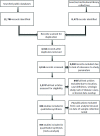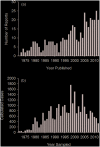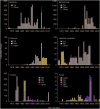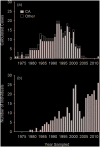A Systematic Review of Changes in Marine Mammal Health in North America, 1972-2012: The Need for a Novel Integrated Approach
- PMID: 26579715
- PMCID: PMC4651562
- DOI: 10.1371/journal.pone.0142105
A Systematic Review of Changes in Marine Mammal Health in North America, 1972-2012: The Need for a Novel Integrated Approach
Abstract
Marine mammals are often cited as "sentinels of ocean health" yet accessible, synthesized data on their health changes that could effectively warn of ocean health changes are rare. The objectives of this study were to 1) perform a systematic review of published cases of marine mammal disease to determine spatial and temporal trends in disease from 1972-2012, including changes in regions and taxa affected and specific causes; and 2) compare numbers of published cases of neoplasia with known, hospital-based neoplasia records to explore the causes of discrepancy between numbers of published cases and true disease trends. Peer-reviewed literature was compiled, and data were collected from The Marine Mammal Center database in Sausalito, California for comparison of numbers of neoplasia cases. Toxicoses from harmful algal blooms appear to be increasing. Viral epidemics are most common along the Atlantic U.S. coastline, while bacterial epidemics, especially leptospirosis, are most common along the Pacific coast. Certain protozoal and fungal zoonoses appear to be emerging, such as Toxoplasma gondii in southern sea otters in California, and Cryptococcus gattii in cetaceans in the Pacific Northwest. Disease reports were most common from California where pinniped populations are large, but increased effort also occurs. Anthropogenic trauma remains a large threat to marine mammal health, through direct mortality and indirect chronic disease. Neoplasia cases were under-reported from 2003-2012 when compared to true number of cases, and over-reported in several years due to case duplication. Peer-reviewed literature greatly underestimates the true magnitude of disease in marine mammals as it focuses on novel findings, fails to reflect etiology of multifactorial diseases, rarely reports prevalence rather than simple numbers of cases, and is typically presented years after a disease first occurs. Thus literature cannot guide management actions adequately, nor inform indices of ocean health. A real-time, nationally centralized system for reporting marine mammal disease data is needed to be able to understand how marine mammal diseases are changing with ecosystem changes, and before these animals can truly be considered 'sentinels of ocean health'.
Conflict of interest statement
Figures






Similar articles
-
Coccidioidomycosis and other systemic mycoses of marine mammals stranding along the central California, USA coast: 1998-2012.J Wildl Dis. 2015 Apr;51(2):295-308. doi: 10.7589/2014-06-143. Epub 2015 Feb 3. J Wildl Dis. 2015. PMID: 25647598
-
Cyclical changes in seroprevalence of leptospirosis in California sea lions: endemic and epidemic disease in one host species?BMC Infect Dis. 2007 Nov 6;7:125. doi: 10.1186/1471-2334-7-125. BMC Infect Dis. 2007. PMID: 17986335 Free PMC article.
-
Association of an unusual marine mammal mortality event with Pseudo-nitzschia spp. Blooms along the southern California coastline.J Wildl Dis. 2009 Jan;45(1):109-21. doi: 10.7589/0090-3558-45.1.109. J Wildl Dis. 2009. PMID: 19204340
-
Transmission of Toxoplasma: clues from the study of sea otters as sentinels of Toxoplasma gondii flow into the marine environment.Int J Parasitol. 2005 Oct;35(11-12):1155-68. doi: 10.1016/j.ijpara.2005.07.002. Int J Parasitol. 2005. PMID: 16157341 Review.
-
Database documentation of marine mammal stranding and mortality: current status review and future prospects.Dis Aquat Organ. 2017 Nov 21;126(3):247-256. doi: 10.3354/dao03179. Dis Aquat Organ. 2017. PMID: 29160222 Review.
Cited by
-
Xenotransplantation of porcine progenitor cells in an epileptic California sea lion (Zalophus californianus): illustrative case.J Neurosurg Case Lessons. 2022 Mar 21;3(12):CASE21417. doi: 10.3171/CASE21417. Print 2022 Mar 21. J Neurosurg Case Lessons. 2022. PMID: 36273868 Free PMC article.
-
Organisation and evolution of the major histocompatibility complex class I genes in cetaceans.iScience. 2024 Mar 27;27(4):109590. doi: 10.1016/j.isci.2024.109590. eCollection 2024 Apr 19. iScience. 2024. PMID: 38632986 Free PMC article.
-
Aspergillus Infections in Cetaceans: A Systematic Review of Clinical, Ecological, and Conservation Perspectives.Biology (Basel). 2025 Jun 7;14(6):664. doi: 10.3390/biology14060664. Biology (Basel). 2025. PMID: 40563914 Free PMC article. Review.
-
Dating the Cryptococcus gattii Dispersal to the North American Pacific Northwest.mSphere. 2018 Jan 17;3(1):e00499-17. doi: 10.1128/mSphere.00499-17. eCollection 2018 Jan-Feb. mSphere. 2018. PMID: 29359190 Free PMC article.
-
Identification of potential welfare and survival indicators for stranded cetaceans through international, interdisciplinary expert opinion.R Soc Open Sci. 2022 Oct 12;9(10):220646. doi: 10.1098/rsos.220646. eCollection 2022 Oct. R Soc Open Sci. 2022. PMID: 36312566 Free PMC article.
References
-
- Vitousek PM, Mooney HA, Lubchenco J, Melillo JM. Human domination of Earth’s ecosystems. Science. 1997;277(5325): 494–499.
-
- Nelson GC, Bennett E, Berhe AA, Cassman K, DeFries R, Dietz T, et al. Anthropogenic drivers of ecosystem change: an overview. Ecol Soc. 2006;11(2): 29, 10.7916/D8125RDD - DOI
-
- Rapport DJ, Costanza R, McMichael AJ. Assessing ecosystem health. Trends Ecol Evol. 1999;13(10): 397–402. - PubMed
-
- Hall B., Kerr M.L., 1991. 1991–1992 Green Index. Island Press, Washington, DC, 162 pp.
Publication types
MeSH terms
LinkOut - more resources
Full Text Sources
Other Literature Sources
Medical

